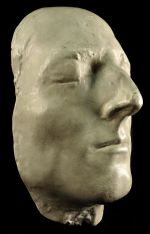Death Masks
 The Hunterian’s Historical Collection contains seven death masks. A death mask is a cast made of a person’s face once they have died. Death masks have several functions; they are a memento of the person who has died, and they are sometimes used as the basis for posthumous sculpture or portraits, or as an effigy of the deceased for state funerals.
The Hunterian’s Historical Collection contains seven death masks. A death mask is a cast made of a person’s face once they have died. Death masks have several functions; they are a memento of the person who has died, and they are sometimes used as the basis for posthumous sculpture or portraits, or as an effigy of the deceased for state funerals.
The Hunterian’s collection includes the death mask of William Cullen (1710-1790), the celebrated surgeon and chemist, who was appointed the first Regius Chair of Medicine at the University of Glasgow in 1744. Cullen’s mask is notable as it shows that his face has fallen on one side, one of the key signs of a stroke. In a similar way, the death mask of Charles XII, King of Sweden (1682-1718) preserves the head wound, caused by a shot, which killed him.
The death mask of Fryderyk Chopin (1810-1849) is cast in bronze and is accompanied by a cast of the maestro’s hand. Chopin’s mask has been altered post-mortem with eye lashes being added and the eyebrows shaped. The mask of The Hunterian’s own William Hunter (1718-1783) is also in the collection, as are the masks of Sir Isaac Newton (1642-1727), Voltaire (1694-1778) and Prince Charles Edward Stuart (1720-1788), “Bonnie Prince Charlie”.
Making masks or likenesses of deceased people is, or was, traditional in many countries. In the 18th and 19th century masks were used in physiognomy (the attempt to analyse a person's character or personality from their outer appearance). It was thought that this might provide insights into famous people and it was also used for anthropological research of other cultures. Since the late 19th century making death masks has fallen out of favour and is now considered rather morbid. The development of the photographic process has also made the technique redundant.

